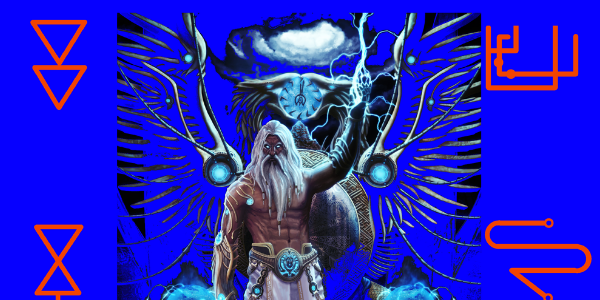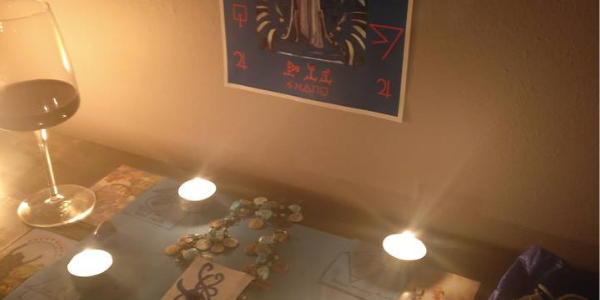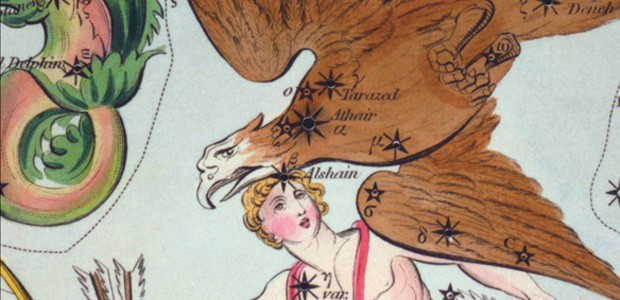
Most people are well aware of religious icons from all over the world, whether in the form of paintings or statues. These icons usually depict the image of a certain god, angel, or saint and are used for communicating with the depicted entity, as well as receiving the grace of that entity more easily than through the use of prayer alone. They are not restricted solely for use inside places of worship such as churches and temples, as many followers of certain faiths have at least one icon inside their house. Certain Christian denominations do not use icons in their worship and point towards the second commandment which says that people should not make any carved image in order to serve it. The fact of the matter is that when using icons in religious worship, people are not praying to the physical depiction of the entity, but to the force which inhabits it instead.
As a practitioner of Western Magical Traditions, I usually work with the spirits associated with that. I use Thelema and Golden Dawn canons mostly, although I incorporate elements of classic grimoire tradition into my work whenever the situation allows it. I also add some religious touch to my work every now and then. This is what made me think about icons and their role in religious worship. And since my mind usually runs wild and comes up with all sorts of unexpected and wacky ideas, it came to me that I can make something similar for my home, but add my own twist to it.
Whenever icons are being consecrated, the entity or entities which are depicted on them come down and inhabit them. Having therefore become homes for spiritual entities, icons can be placed on a personal altar at home, and the people who use that altar will interact with the housed entity as often as they want. Whether being worshiped by a single individual or the whole family, the spirit inside an icon will exert its powers upon that household. It is thus indicated that one ought to not only ask for this and that from the spirit all the time, but to also perform regular devotional work towards it. One of the reasons for doing this is to show the spirit that you do not use it as if it were a machine, and that you offer something back in return for its help. Prayers of adoration are in order, because showing respect for the spirit will keep it happy and willing to help you further on. Another reason for this is to empower the spirit so that it can provide you with its help more easily and in a more powerful way. Therefore, one can also make offerings to it which can vary from a simple tea light candle or flowers to all-out cooked meals. Keeping the icon and the space around it clean is also a good idea, and a form of showing respect.
People can usually find such objects being sold inside places of worship or in certain stores which sell them. In many cases, the person would have to have the icon consecrated if they want to have a genuine spiritual object inside their home, and not a mere piece of wood or plaster. Magicians, however, can consecrate such objects themselves, and can do so according to their own intent and liking. And since they can consecrate it, then why couldn’t they create it in the first place? My aim is to provide the reader with information on how to create icons for the planetary forces in the form of paintings. The reader is free to adapt it in order to create such paintings for elemental and zodiacal forces as well, or any other entity they choose to, as the process is the same. I am going to present the process of how I did mine, and you are free to use your imagination for coming up with ways to improve it.
Creating the image
The first thing I did was create the image for the icon, which in this case was created for Jupiter. Having limited photo editing skills, I downloaded an image of the god, around which I painstakingly drew the various images associated to Jupiter: His planetary seal, planetary glyph, and the sigils for the planetary angel, intelligence, spirit, and Olympic Spirit, along with three different geomantic characters for the geome Aquisitio. I use Celestial script to write the godname ABA, which Agrippa attributes to Jupiter. I also wrote Tzedeq, the heaven of Jupiter according to Crowley’s Liber 777, and the name of Sachiel, the planetary angel of Jupiter. As you can see in the image, I used orange for the writing on a blue background in order to create a flashing colors effect, since most people are aware that blue is the color of Jupiter. The flashing colors effect is has several applications, especially when it comes to exercises that enhance one’s scrying and astral vision. Two complementary colors put together appear to vibrate and flash when gazing upon them even for a short while.
If you are more skilled at this than I am, then I am sure you can come up with a more fancy design. I would’ve loved it if I were able to actually paint it myself, but my skills as a painter are even weaker that my photo editing ones. I drew a 4×4 kamea of Jupiter on the inside of the back of the frame to help in drawing the energy of the planet even more. Once the image was completed I printed it and framed it in a blue frame. I would have loved to add a piece of tin inside of it, which I would’ve also inscribed with some Jupiter symbols, but I couldn’t find such a thin piece of tin before I was about to consecrate the painting. As you can see, this was all very simple to do, but you can get creative and add as many symbols and items to it as you like. My friend Jillian, for instance, simply printed it and taped it on the wall above her altar, then started working with it right away.

For the consecration itself, I opted for a two-part working performed in consecutive Thursdays. This is because the first Thursday was under the influence of a lengthy Void of Course Moon, and I am one of those practitioners who take that into consideration whenever I’m planning rituals and conjurations. So I went ahead and opened my ritual as usual, tuned the space for Jupiter, but I did not conjure any spirit. Instead I cleansed the painting with some frankincense and holy water, then I lit some cedar incense next to it and read four Psalms associated with Jupiter over it, provided by Ye formidable magician or our times, Aaron Leitch in his work Codex Septemgenius: Psalm 104, 112, 113, 125. I finished by closing the ritual and allowing the incense to consume itself, before I wrapped the painting in a protective bag and set it aside until the following week. The following Thursday I performed another ritual in which I conjured the spirits Sachiel, Iophiel, and Hismael and asked them to charge the painting in such way that it will bring the good energies of Jupiter inside the home it is located in. I gave the spirits four blue candles and cedar incense in exchange for their willingness to reside within the painting. Once that was done and the candles burned out completely, I hung the painting on my wall. The ritual for conjuring spirits that I use is that of Scott Michael Stenwick, although I make use of the sigils of the spirits differently. That is to say, I draw the sigil of the planetary angel according to the Magical Calendar and add the sigils of the intelligence and spirit next to it, as found in Agrippa’s Books of Occult Philosophy. The sigils are written as such on the painting too, as I figured using the classic one for Sachiel would offer more aesthetic value, but you can create his sigil using the Jupiter kamea if you want to.
Consecrating your icon
I know that my painting also contains the seal of Bethor, the Olympic Spirit of Jupiter, though I did not conjure him. This is not a problem, as I think he is making himself felt within the painting too. This reminds me to talk a bit to people who have yet to start conjuring spirits: If you are a beginner and are reading this article thinking you do not have the skills and knowledge to perform such rituals, you need not worry! You can fashion such a paining and simply ask the Olympic Spirit of the planet to charge it. The ritual with the Olympic Spirit is very simple, as presented in this article by Nick Farrell, and it can be performed by anyone. People who lean more towards the Solomonic tradition are free to cleanse and consecrate the painting according to The Key of Solomon, by observing the specific times and procedures mentioned in there.
Now that I have the painting on my wall, I light a blue candle in front of it every Thursday and occasionally some cedar incense, thanking the spirits for helping me and asking them to keep up the good work. I have placed my painting in my living room because I live in an apartment, and therefore I have no attic or loft, which according to Jake Stratton-Kent is the room associated with Jupiter. If you want to create paintings for each planet and you want to place each of them in the room associated with that planet, then the living room is associated with Sol, the kitchen with Luna, the study or office with Mercury, the hallways with Saturn, the bathroom with Mars, and the bedroom with Venus, naturally. In case you are not so eager to welcome Saturn and Mars into your house because of their bad fame as being malefics, you can think of things from another perspective. Saturn can help reinforce the structure of your home, keep unwanted spirits, both incarnated or not, away from the area, as well as it can provide help with timing, patience, commitment, and efficiency. Mars can protect your home from the likes of burglars and aggressors, as well as help one with discipline and assertiveness.
You can also anoint the painting regularly with the appropriate essential oil, or a special planetary oil brewed by someone who usually does this. But I figure it would be nice to spend some more energy in this direction and create a simple planetary concoction myself. I do not call it oil; it incorporates oil, but it does not follow the brewing process regular occult oils are made by. Instead, I got inspired by Aaron Leitch’s planetary herbal waters articleand created concoctions which I use either for anointing myself, or as offerings to the spirits. The process for consecrating such concoction is very simple, and you will only need to read Psalms of the planet you are making the concoction to, in the appropriate number, and at the appropriate time.
The process of making it implies adding together ingredients corresponding to the planet it’s being made for. So for Jupiter I used olive oil as a base, which works well as a base for most blends, although I would use sunflower oil for the Sun, hazelnut oil for Mercury etc. I ground four walnuts into a powder, and add to it some nutmeg powder and some powdered dried hyssop, then mixed all of it together with the olive oil until I got a homogeneous paste. You can use different ingredients for this, as long as you respect the correspondences which are easily accessible with an online search. I charged the paste by reading the four Jupiter Psalms over it in the appropriate day and hour, while lighting a blue candle and some cedar incense next to it. I found that making the whole thing into a paste works very well with offerings, as the paste can be spread on bread and the spirits will love it. Of course, you can make it as an oil instead, and just add a pinch of nutmeg powder and dried hyssop to the olive oil, along with a walnut kernel. This way you can anoint yourself with it without making too much of a mess.
Conclusion
I would recommend you perform this while the Moon is in her waxing phase though, as I do with all such paintings. You can choose a waning Moon phase however, if the goal is to keep someone or something out of your home.
I hope this article about making and consecrating planetary paintings will give you plenty of ideas for making your own. Feel free to use whatever ritual protocol you are used to, so long as you can get the spirits to show up and inhabit the painting. Once that’s done, start working with them and witness the magick manifesting into your life.
Image credit: I. Alejandro Virgilio






